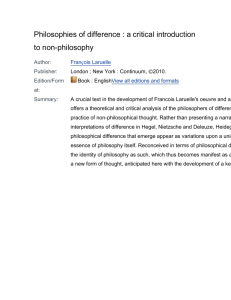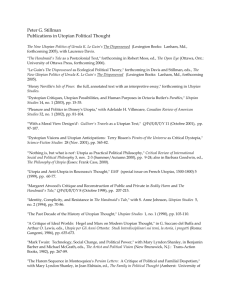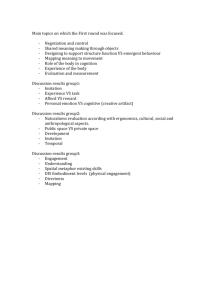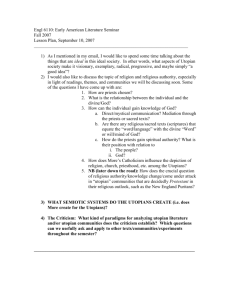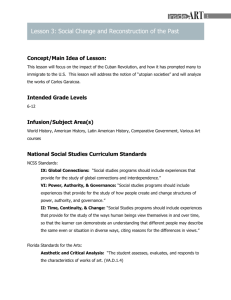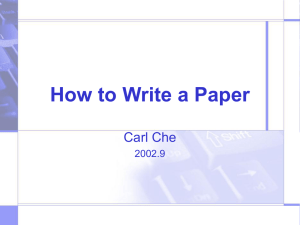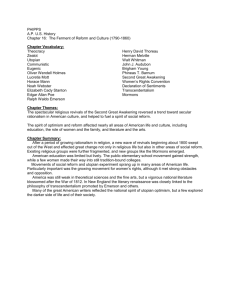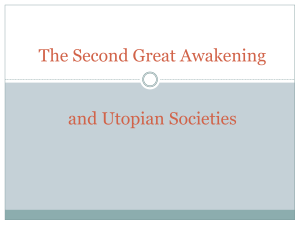The Utopian Brain Amanda Giorgio WPSA 2014 This presentation
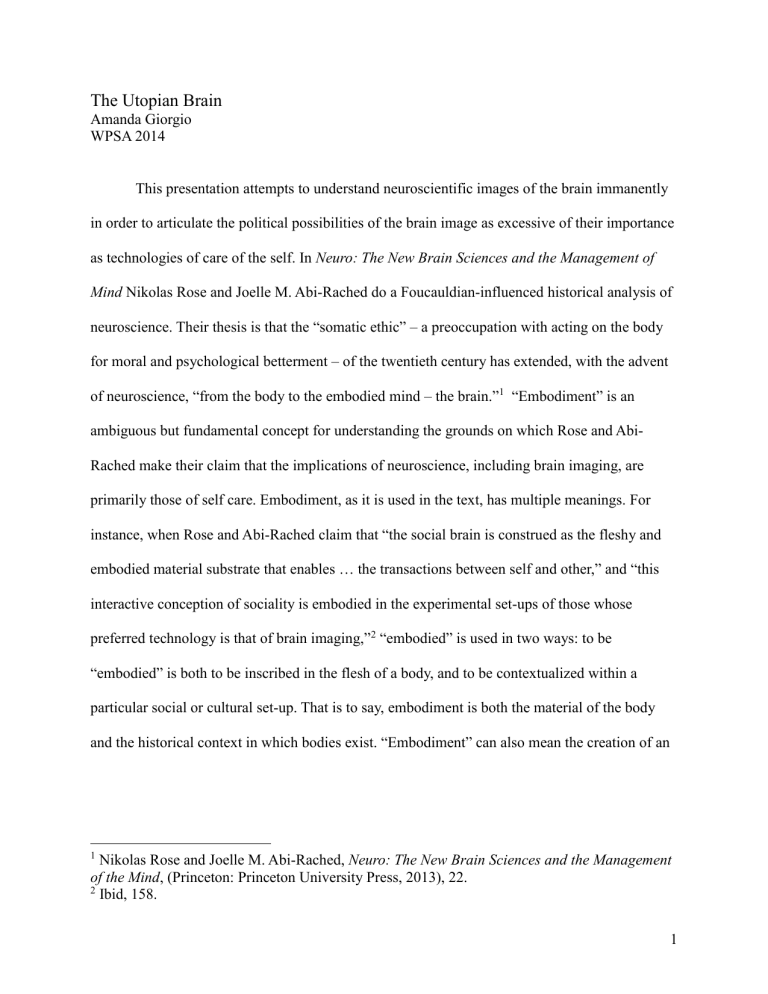
The Utopian Brain
Amanda Giorgio
WPSA 2014
This presentation attempts to understand neuroscientific images of the brain immanently in order to articulate the political possibilities of the brain image as excessive of their importance as technologies of care of the self. In Neuro: The New Brain Sciences and the Management of
Mind Nikolas Rose and Joelle M. Abi-Rached do a Foucauldian-influenced historical analysis of neuroscience. Their thesis is that the “somatic ethic” – a preoccupation with acting on the body for moral and psychological betterment – of the twentieth century has extended, with the advent of neuroscience, “from the body to the embodied mind – the brain.” 1 “Embodiment” is an ambiguous but fundamental concept for understanding the grounds on which Rose and Abi-
Rached make their claim that the implications of neuroscience, including brain imaging, are primarily those of self care. Embodiment, as it is used in the text, has multiple meanings. For instance, when Rose and Abi-Rached claim that “the social brain is construed as the fleshy and embodied material substrate that enables … the transactions between self and other,” and “this interactive conception of sociality is embodied in the experimental set-ups of those whose preferred technology is that of brain imaging,”
2
“embodied” is used in two ways: to be
“embodied” is both to be inscribed in the flesh of a body, and to be contextualized within a particular social or cultural set-up. That is to say, embodiment is both the material of the body and the historical context in which bodies exist. “Embodiment” can also mean the creation of an
1
Nikolas Rose and Joelle M. Abi-Rached, Neuro: The New Brain Sciences and the Management of the Mind , (Princeton: Princeton University Press, 2013), 22.
2 Ibid, 158.
1
image, as when a particular kind of doctoral gaze is “embodied in a multitude of anatomical models.” 3
Embodiment is the state of being in a “configuration.” A configuration is the condition of possibility for interpretation, “[w]hen we speak of rendering the mind visible, we do not just mean the act of seeing. We mean the whole configuration by means of which a certain way of seeing becomes possible.” A configuration has three dimensions: a) spatial and temporal, b) technological and c) practical (the way brain imaging is practiced). Or, to reconfigure Rose and
Abi-Rachad’s formula, the practice of brain imaging that authorizes some to subjectify others is supported by the material of body and technology. Configuration is that which enables images to
“render ‘mind’ thinkable.” 4
Brain imaging has a configured quality that helps determine the image’s interpretation.
The brain image is a record of information that must be visualized in order to be understood, but which cannot be visualized without a distortion of data. Rose and Abi-Rached compare contemporary brain imaging to photography of the mentally ill in the nineteenth century.
Photographers of the psyche claimed to be depicting the reality of mental states, even while their photographs were carefully staged.
5
Contemporarily, brain images are likened to maps, which are tools that are meant to allow information to be understood and committed to memory in the quickest way possible.
6
In order to create these “maps,” data must be transformed, smoothed, warped and stretched into that which is cumulable, intelligible and interpretable. Brain images must also undergo an aestheticiztion through color – the way brain images are colored is
3
Ibid., 156
4
Ibid., 54
5
Ibid., 60
6 Ibid., 58
2
“artifactual” in the sense that any given color scheme for an image is unnecessary, but is nonetheless suggestive to non-scientists through cultural “conventions.” 7
It may be useful to stop here and note that brain images are ever increasingly the primary product of neuroscientific research. More so, perhaps, than words or numbers. With the advent of technologies that can take “photos” of the brain at increasingly microscopic levels, scientists themselves can’t understand the information about the brain they are searching for without visualization, the information they are searching for is visual. Indeed, Barack Obama’s BRAIN initiative is dedicated to a visual “map” of the brain as a product of scientific inquiry. Therefore, visualization, which is necessarily “artifactual,” “conventional,” and “distorting,” makes claims to producing “real” thought images of the brain system, insofar as those images can be considered the product of scientific discovery. But, according to Rose and Abi-Rached, this
“realism” is both misguided as a truth practice and a problematic production of power. Although
Rose and Abi-Rached take pains to point out that these images are not themselves “irreal,” it is precisely the fact that the production of brain images requires “distortion” that seems problematic. This distortion can also take place as flawed reasoning. Studies that compare fMRI images to different kinds of stimuli in order to explain specific psychological responses – Rose and Abi-Rached’s example is a study of “social pain” – simply fail to realize that fMRI images are too imprecise to support that kind of interpretation. Flawed reasoning, like artifactuality, indicates the mistakenness of “the attribution of false concreteness to [the brain image] by researchers, policymakers, and popular interpreters.”
8
In order to avoid this mistakenness, “the image should be understood not as picture to be judged via a criterion of realism, but as a tool, as a move in an argument, an instrument in an intervention, to be judged by a criteria of rationality,
7
Ibid., 78
8 Ibid., 81
3
validity, or efficacy.” 9
Brain images, then, are best understood as scientifically sanctioned rhetorical devices, whose claim to the real is dangerous.
But claiming a rhetorical place for brain images doesn’t solve the problem of the “irreal,” because the configuration, the embodiment, of these brain images, is real according to Rose and
Abi-Rached: “the laboratory is not a ‘non-space’: it is itself a real configuration of persons devices and techniques, which imposes its own characteristics on the data generated, as well as the interpretations made of them” (228). Configuration is real because it imposes both the conditions of embodiment, and the interpretation, the rhetoric, of the brain image. In this sense, while brain images are not subjected, to an “untenable realism” by Rose and Abi-Rached, material (that which is in space-time), technology and practice are. This dualism between the
“real” conditions under which brain images are produced, their embodiment, and their rhetorical character insofar as they are conditioned by their embodiment, indicates a problem with analyzing brain images historically: brain images propose something other than a material historicity. We are left with a nagging question, one Rose and Abi-Rached side-step by claiming not to be philosophers, but rather historians: if they are describing the embodiment of an
“emerging neuro-ontology” what is “embodiment,” and what reason do we have to rely on it as a criteria for knowledge?
In order to understand this problem of embodiment and its intimate relation to images of the brain, let us turn first to the source of Rose and Abi-Rached’s historical-theoretical vocabulary, Michel Foucault. Foucault addresses the problem of the real of the body in his 1966 radio lecture “Utopian Body.” Foucault starts this lecture speaking about utopias of the body – dreams of flying, dreams of immortality – then shifts to the utopian body, making utopia
9 Ibid., 81
4
immanent to the “I.” He does so on the grounds of the body’s irreducibility, it’s inescapability.
The body’s irreducibility is focused first in the head, “[m]y head for example, my head: what a strange cavern that opens onto the external world with two windows.” 10
The head is irreducible, but cavernous, empty. The place of the “I” that peeks out of two windows is an absent place. The
“I” place isn’t a place unless it’s in pain. The body is light, transparent and imponderable until it is hurt, and then “I” becomes thing, “fantastic and ruminated architecture.” But architecture is lived in , it’s a space, an empty place, except for that which dwells in it, the I. The I is both dwelling and dweller. This formulation is deceptive, however, because the utopian body is flickering – its architecture comes into and out of being – rather than split.
In fact, the utopian body is that which unifies the world: “[t]he body is the zero point of the world. There, where paths and spaces come to meet, the body is nowhere. It is at the heart of the world, this small utopian kernel from which I dream…it is no place, but it is from it that all possible places, real or utopian, emerge or radiate.” 11
The utopian body’s character as that which is profoundly immanent is also what makes it profoundly other, profoundly nowhere. This irreducible otherness of immanence is a utopian rage, “the body turns its own utopian power against itself, allowing all the space of the religious and the sacred, all the space of the other world, all the space of the counter world, to enter into the space that is reserved for it. So the body, then, in its materiality, in its flesh, would be like the product of its own phantasms.” 12
This rage is a kind of immanent restlessness, that can only be appeased by other utopias, the mirror or the corpse. The mirror and the corpse shut utopian rage into a closure, so that the body is not a pure utopia, but creates other utopias, creates worlds.
10
Michel Foucault, “Utopian Body” trans. by Lucia Allais in Sensorium: Embodied Experience,
Technology and Contemporary Ar t (Boston: MIT Press, 2006) 228
11
Ibid.
12 Ibid., 232
5
In this lecture, Foucault uses the term “embodiment” a single time. Following Lacan,
Foucault notes that babies are a “dispersed body of limbs, cavities, orifices,” and “all of this only gets organized, all of this gets literally embodied only in the image of the mirror.” 13
The image of the mirror is, of course, a utopia. The conflation that occurs in Rose and Abi-Rached's work between embodiment, which may indeed be the “real” for Foucault, and configuration as a historical and material state, cannot be supported by a conception of the utopian body. In this light, the brain image, which is a double-utopia of mirror and corpse, cannot be juxtaposed to the configuration of its development and use, but must be understood as positing a real that is precisely “nowhere”: utopian.
Foucault’s lecture is short, however, and doesn’t quite give us a satisfactory answer to our problem. Now that “embodiment “ happens through the confrontation between the utopian body and the utopia – in this instance – of the brain image, are we still left with the brain image as a technology of care of the self, a tool in a phenomenological event? Laruelle takes up the idea of the body as utopia for what he calls “non-philosophy,” and he does so in relation to the image in his short book Concept of Non-Photography . The key to understanding Concept of Non-
Photography and, as we shall see, understanding Laruelle’s commitment to the future lies in understanding “vision force.”
Vision force, for Laruelle, is the stance of the photographer. Like Foucault’s utopian subject, the photographer is frustrated by the irreducibility –here “finitude” – of the body, by “an impotency in regard to oneself, a powerlessness to leave oneself so as to go amongst things – the intrinsic finitude of a vision condemned to see according to itself and to remain in itself – but
13 Ibid.,233
6
precisely without being, for all that, a rational subject ‘looking down on’ the World” 14
Rather than “rational,” the photographer is characterized by an “undivided and precisely non-intentional vision-force.” As such, the radical immanence of the “stance” of the photographer, vision-force, is a utopia: “the ‘photographic’ body is not a site or a place, but a utopian body whose very reality, whose type of reality qua ‘force’, leaves it with no place in the World.” 15
The restlessness, the frustration, of the utopian body is vision-force. But vision-force is not objectifying, it doesn’t seek objects that are beyond, or determined by, thought. Instead it
“precedes the World,” and as such is immanent in a way foreclosed to perception, or “being-inthe-World,” where being is precisely not utopian. The object of imaging is found not in the
World, but in the utopian body and the image,”in the process that goes from one to the other.” 16
This process may be a kind of manifesting, and the most intensely immanent process of manifesting (photographing, imagining) is manifesting-utopia.
The photograph, because of it relation to vision-force is its own “Identity–in-the-lastinstance”. This formulation of Laruelle’s is meant to free the image from reduction to either its
“conditions of existence, whether perceptual, optical, semiotic, technological, unconscious, aesthetic, political” or the idea that it produces “perception, optical technology, aesthetic codes.” 17 We can see, then, that photography, or imaging, as “Identity-in-the-last-instance,” is a rejection precisely of the reality of a configuration. Laruelle, on this basis, dismisses the content of the photo in favor of the “process” between vision-force and photo.
However, I’d like to argue that brain images are images of vision force as such because they use technology in order to develop an image of that which is profoundly utopian, the “I”. As
14
Francoi Laruelle, The Concept of Non-Photography (New York: Sequence, 2011)
15
Ibid.
16
Ibid., 18
17 Ibid., 35
7
mentioned above, for many neuroscientists, images of the brain are the primary product of research. Insofar as this is the case – and it isn’t always– brain images are the “naïve” stance of science par excellence
. To dismiss the “flesh,” the motif, so to speak, of the brain image, isn’t tenable, precisely because what neuroscientists are imaging is not just material, but embodiment.
Therefore, the brain image doesn’t embody, it destroys embodiment precisely because it makes claims to the real. The brain image, still following Laruelle, is not simulacrum, but images vision force, it images the process of the real that is real, is immanent, precisely because it is not inscribed in “the World” or what we have been calling “configuration.” 18
Thus, vision-force is confronted with vision-force.
What this does for us, is it allow us to prioritize what Laruelle calls “Man” or
“Humaneity,” or, most relevantly “human-force.” To prioritize human-force as that which is its own determination in the last instance is to free it from what Laruelle calls, in Struggle and
Utopia at the End Times of Philosophy, “harassment.”
19
Harassment is also “Hell,” or “Principle of Sufficient World,” 20
and it is characterized as “a crime without declared violence.”
21
Harassment is imperatives imposed on Man by the World. In our example, harassment is the somatic ethic that Rose and Abi-Rached identified in their work. Which is to say that brain images don’t have to present an imperative embodiment, they do not have to be technologies or configurations of the self. Instead, taken in-the-last-instance, brain images confront us with our own vision-force, our own immanence, our own determination-in-the-last instance, and it is this utopian embodiment that allows for a real politics of the future.
18
Ibid., 25
19
Francois Laruelle, Struggle and Utopia at the End Times of Philosophy (Minneapolis:
Univocal, 2004), 17.
20
Ibid., 19
21 Ibid., 17
8
9
WORKS CITED
Foucault, Michel. “Utopian Body” trans. by Lucia Allais in Sensorium: Embodied Experience,
Technology and Contemporary Art , Boston: MIT Press, 2006.
Laruelle, Francois. Struggle and Utopia at the End Times of Philosophy . Minneapolis: Univocal,
2004.
Laruelle, Francois. The Concept of Non-Photography . New York: Sequence, 2011.
Rose, Nikolas and Joelle M. Abi-Rached. Neuro: The New Brain Sciences and the Management of the Mind , Princeton: Princeton University Press, 2013.
10
